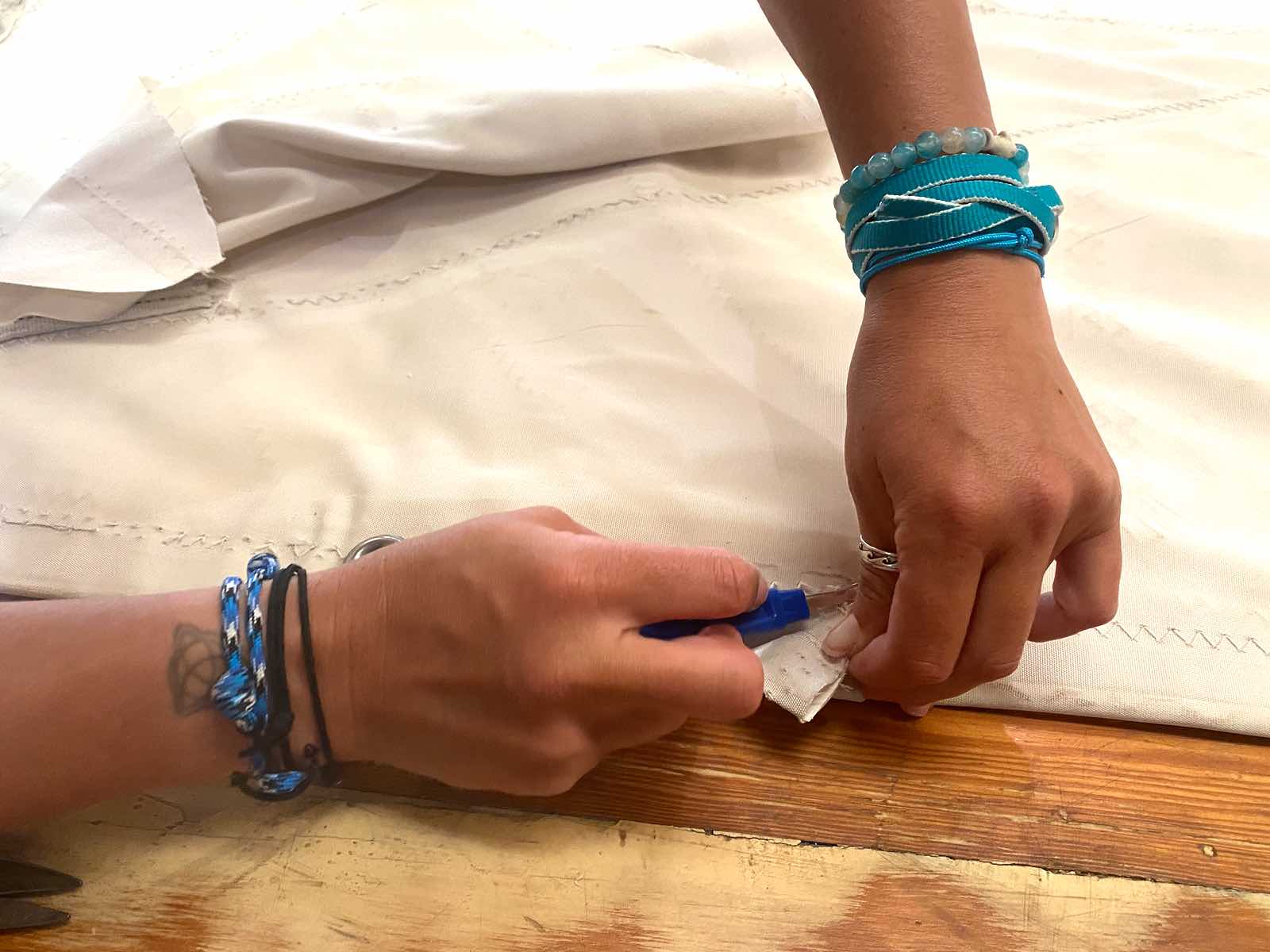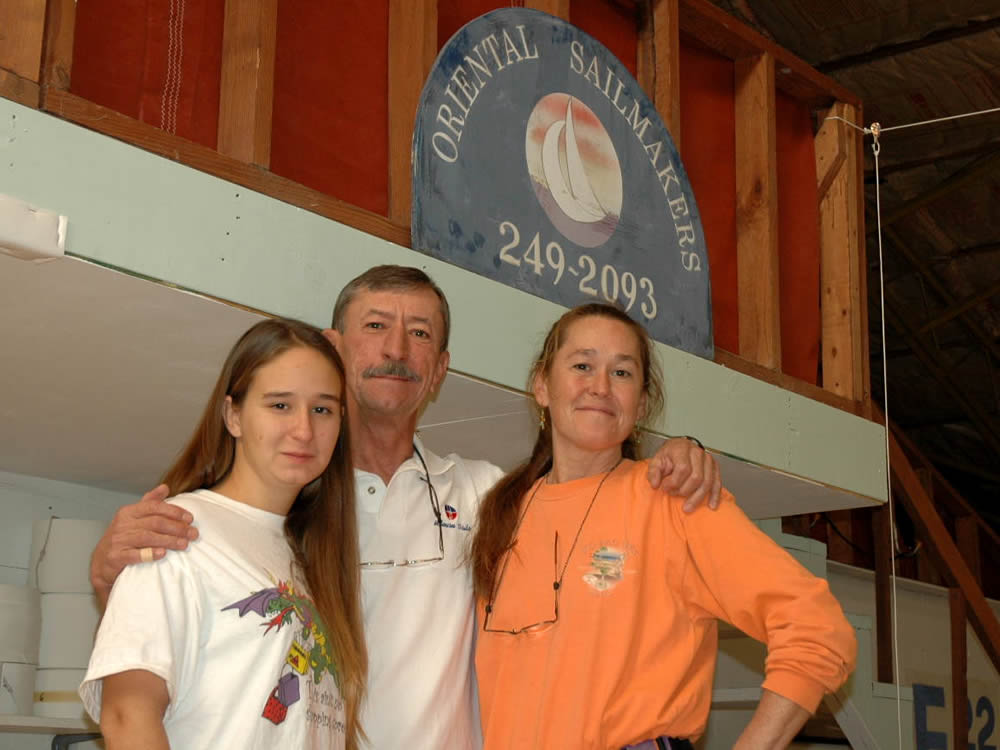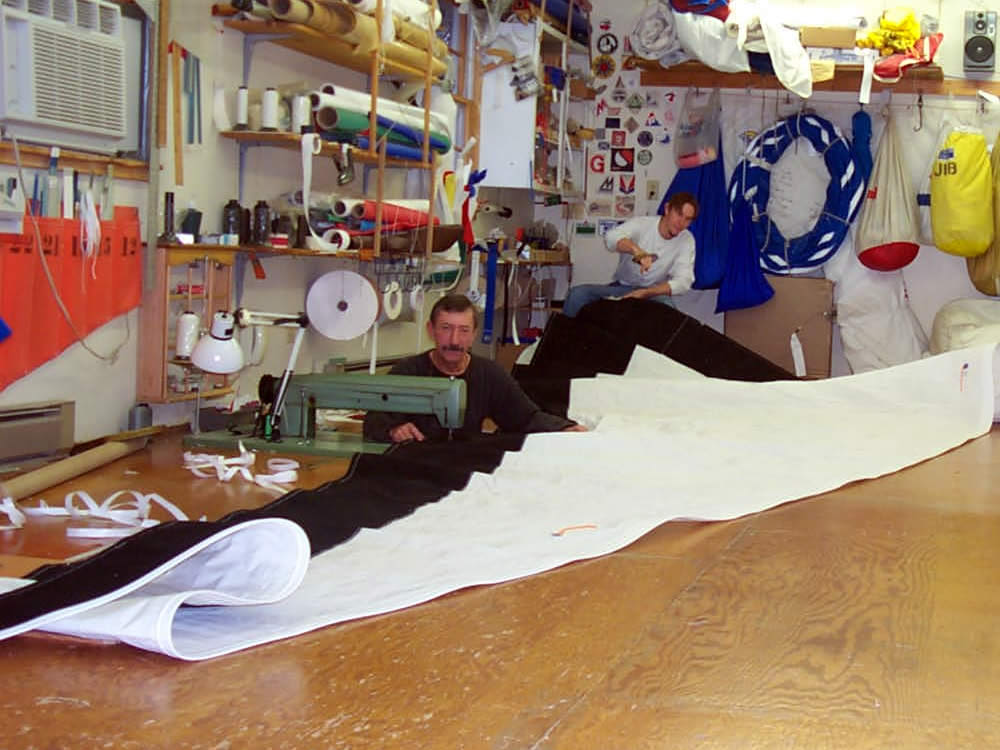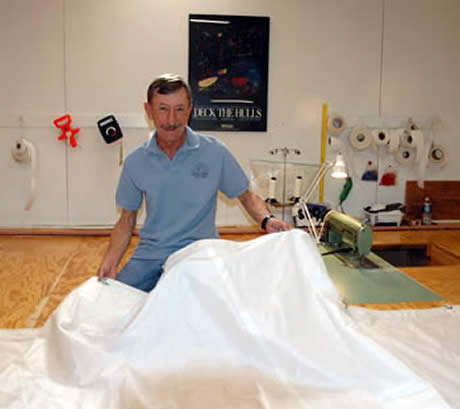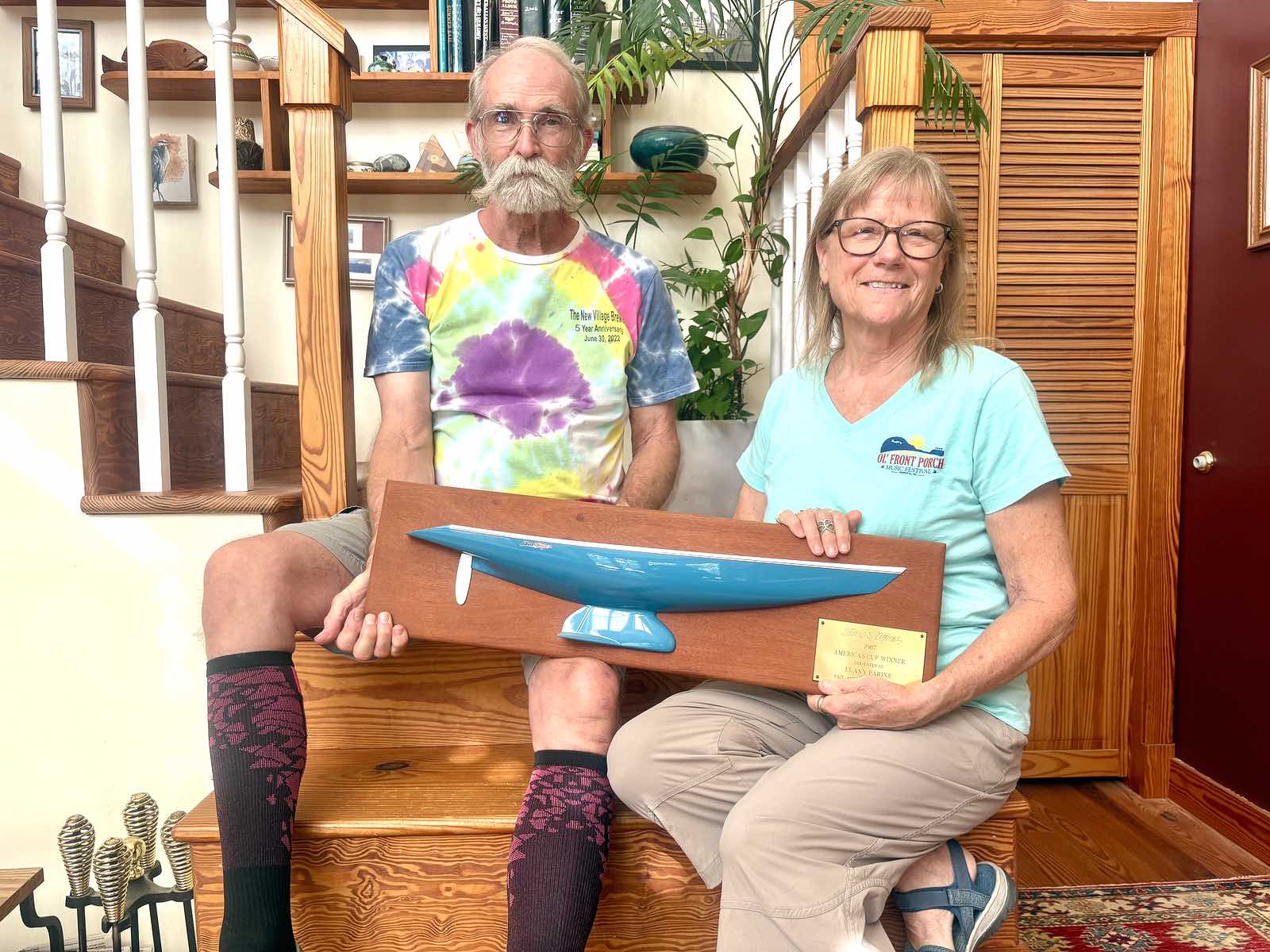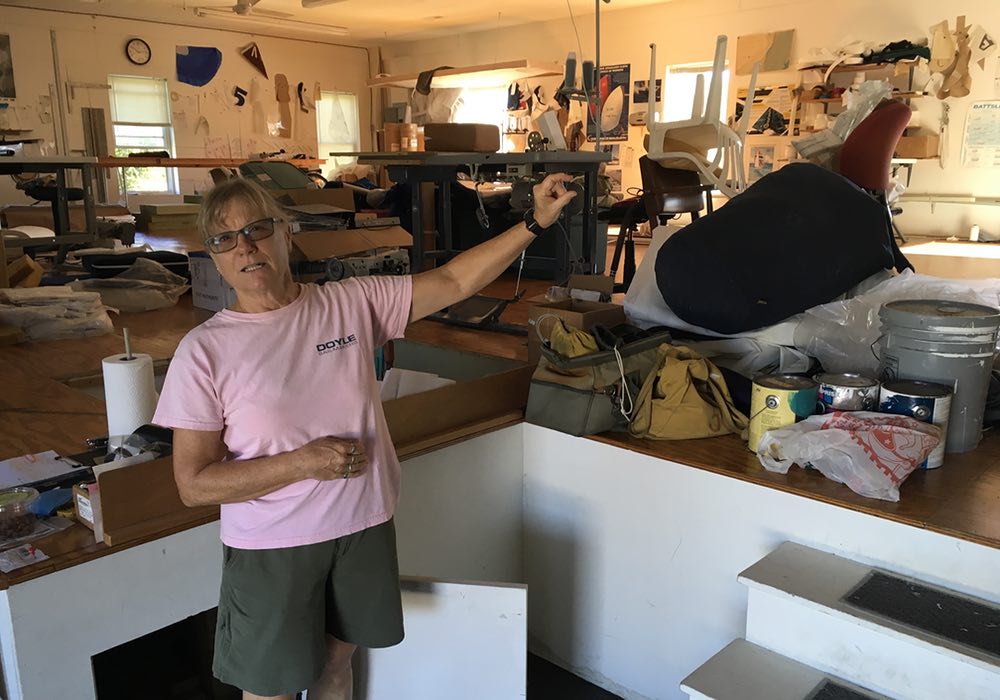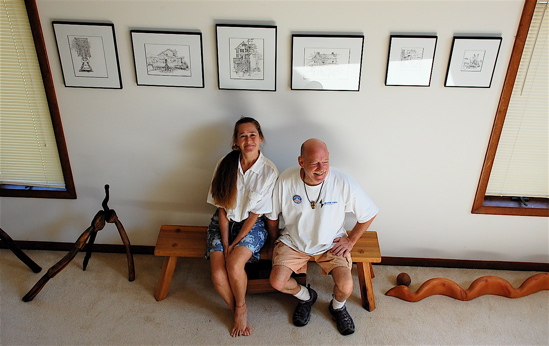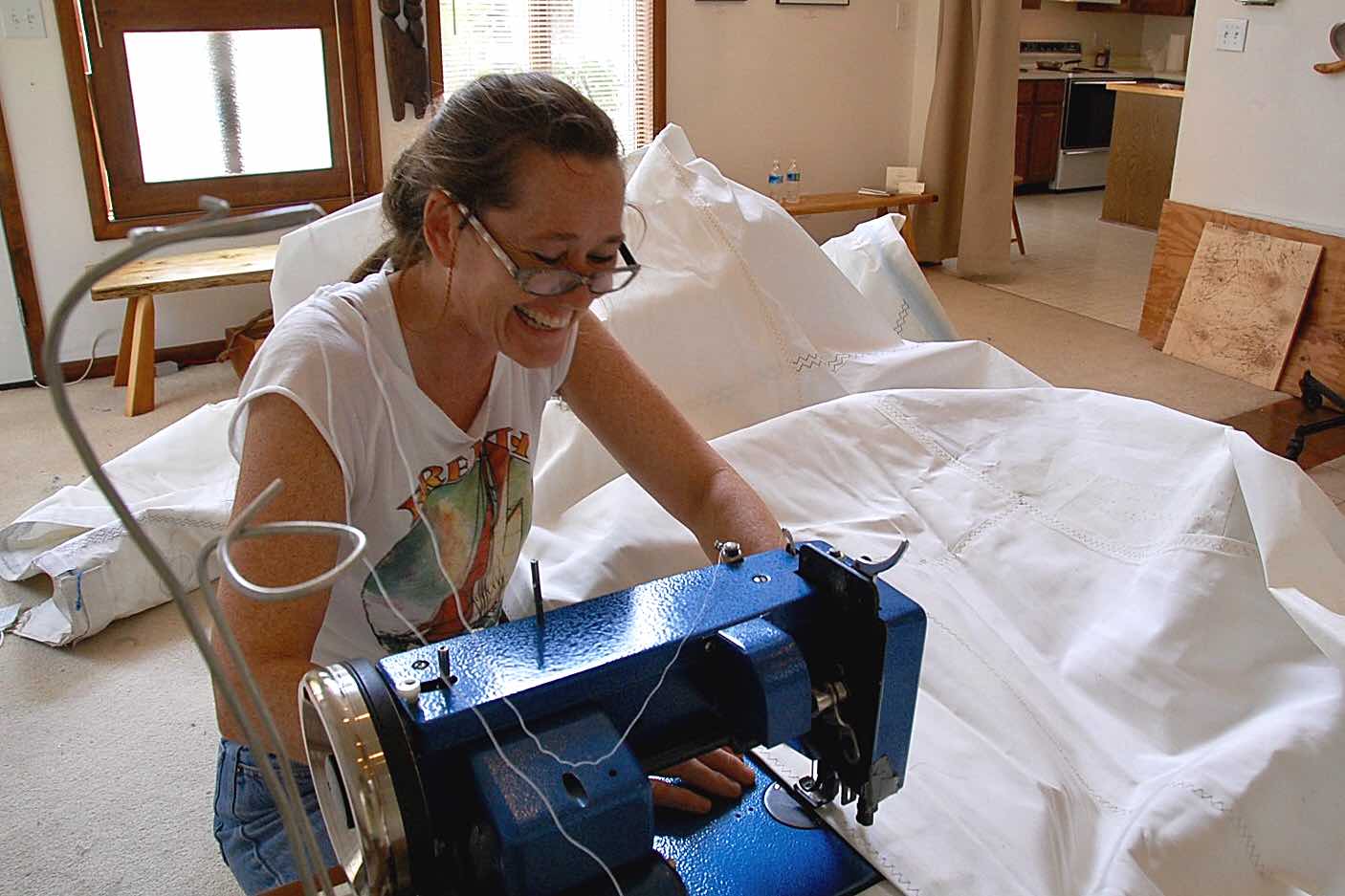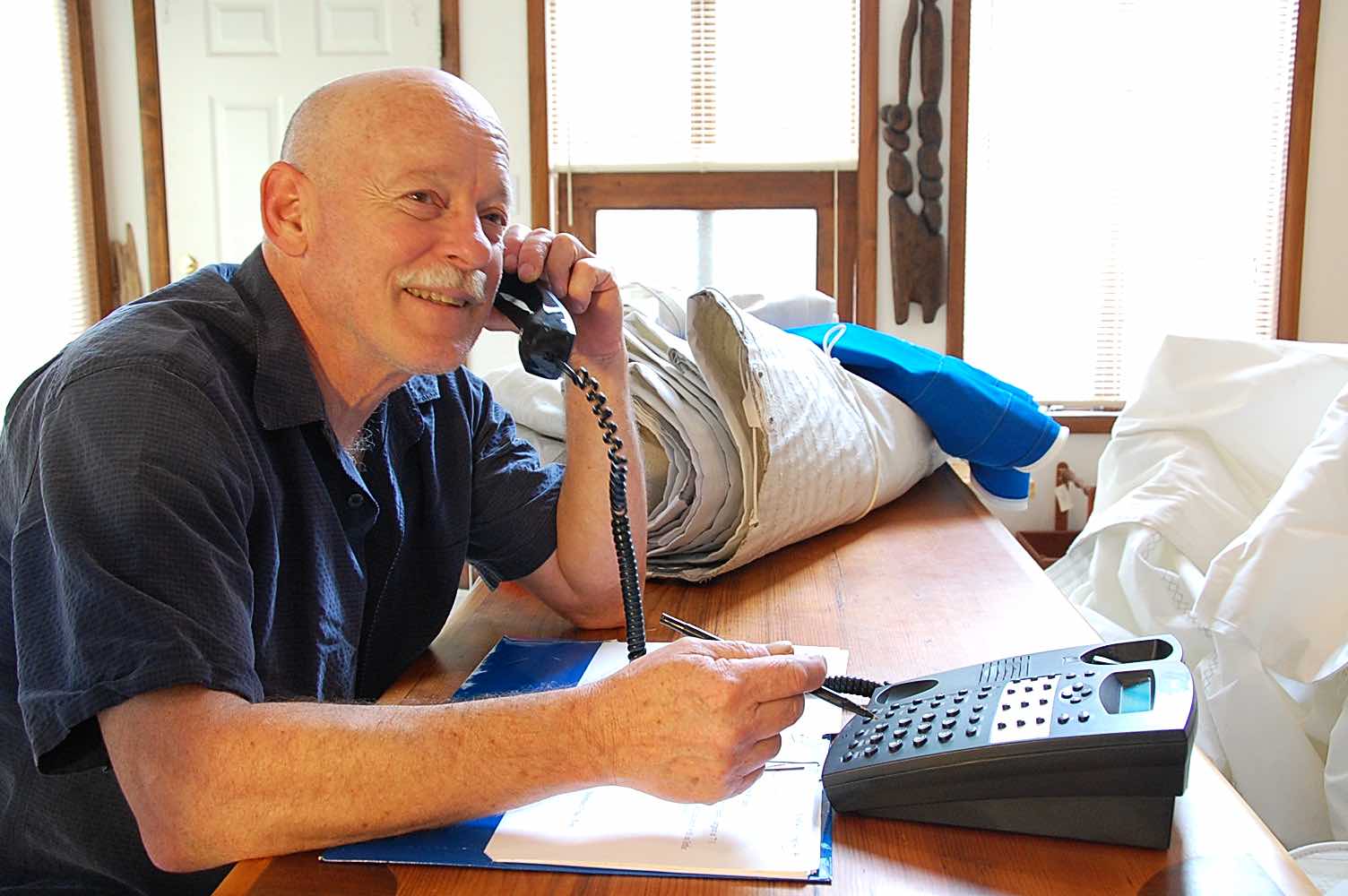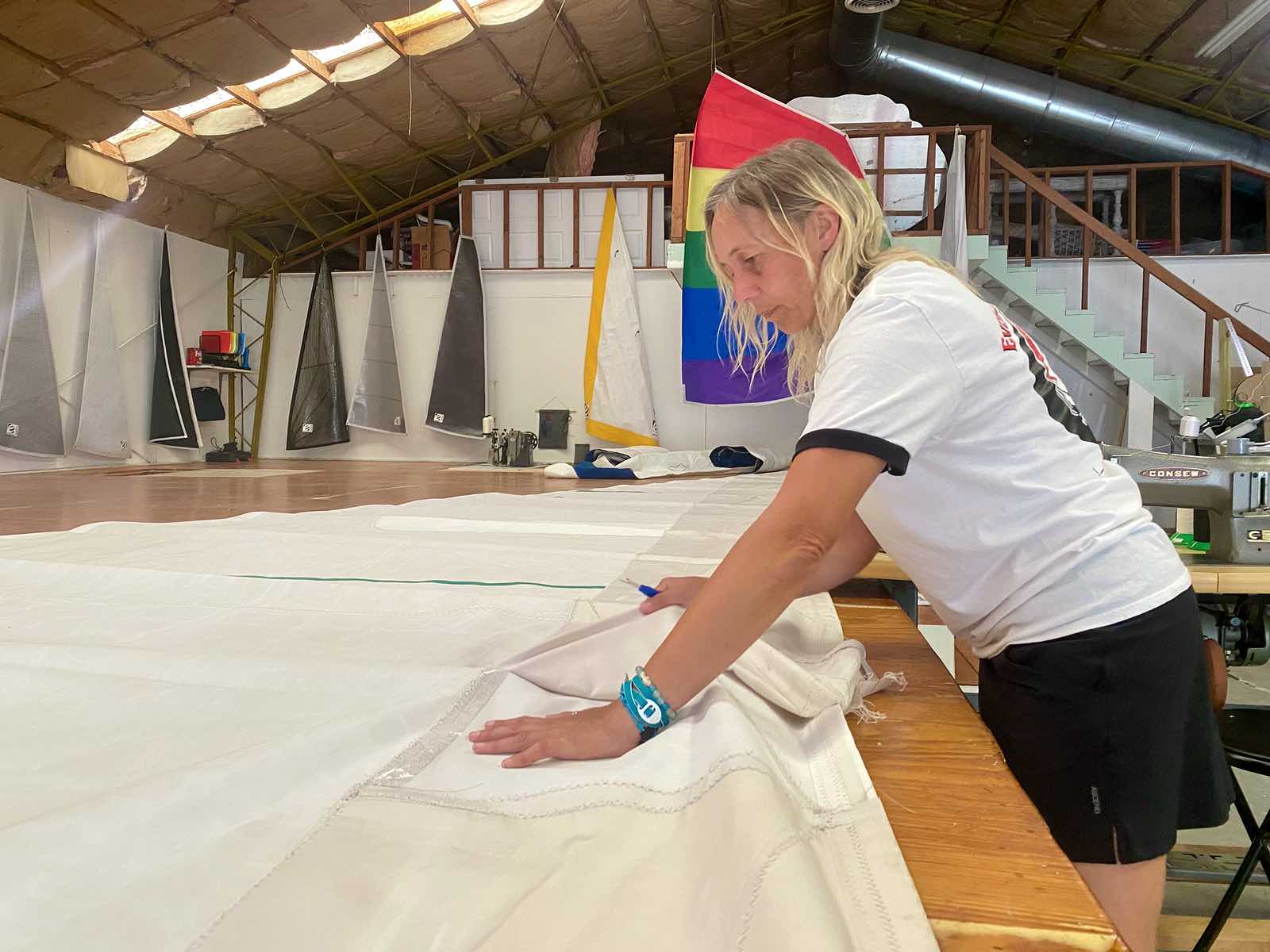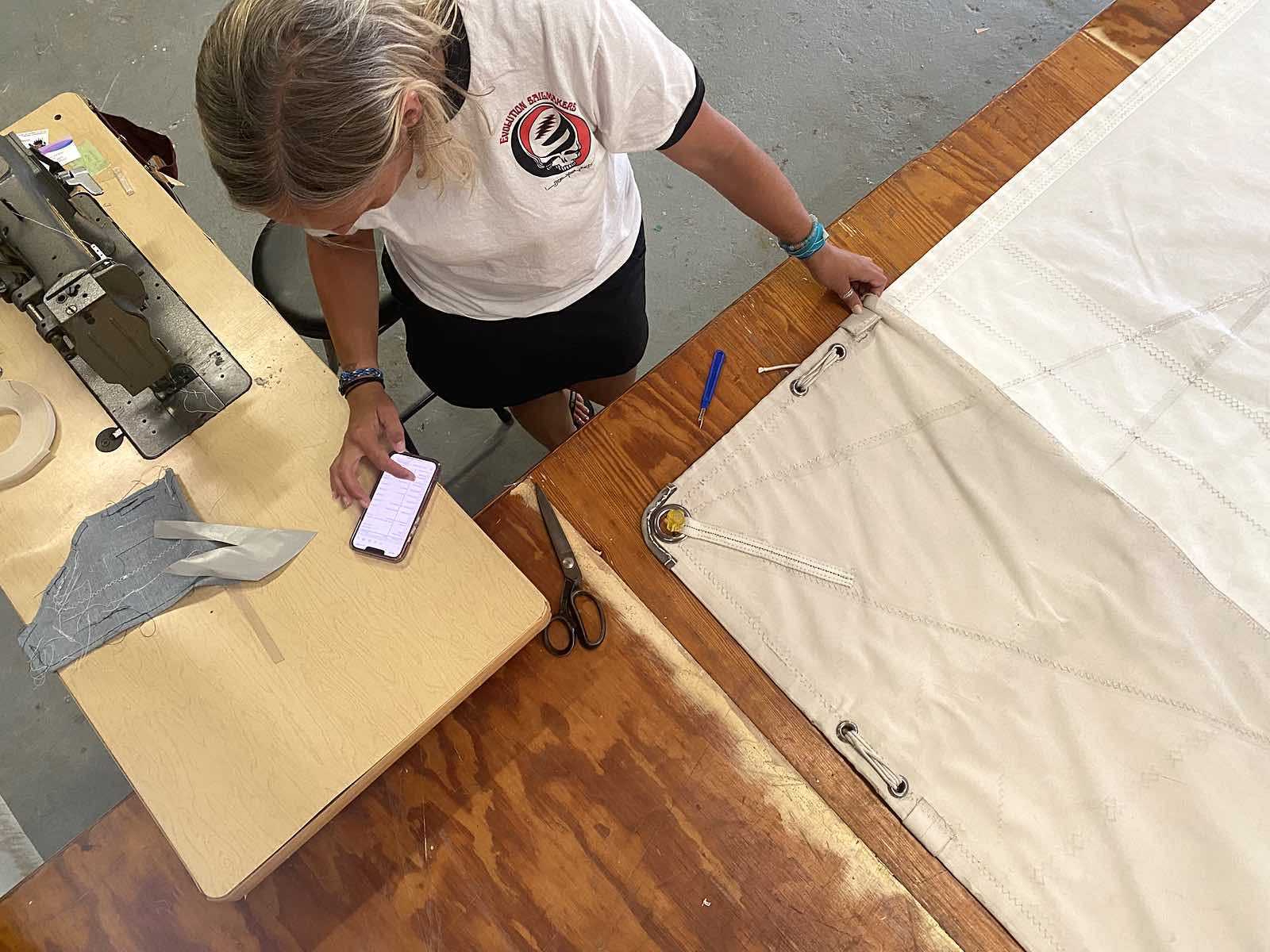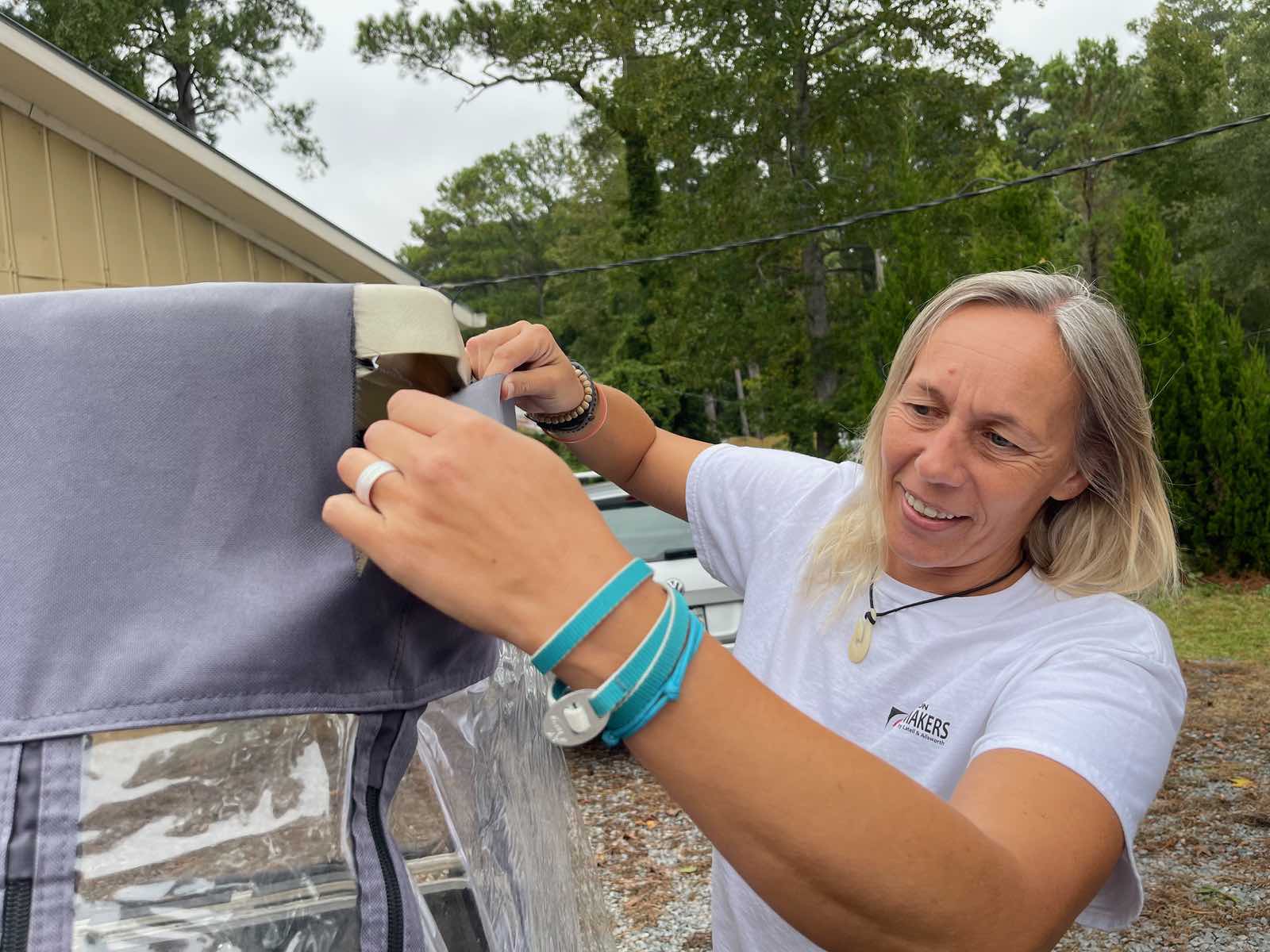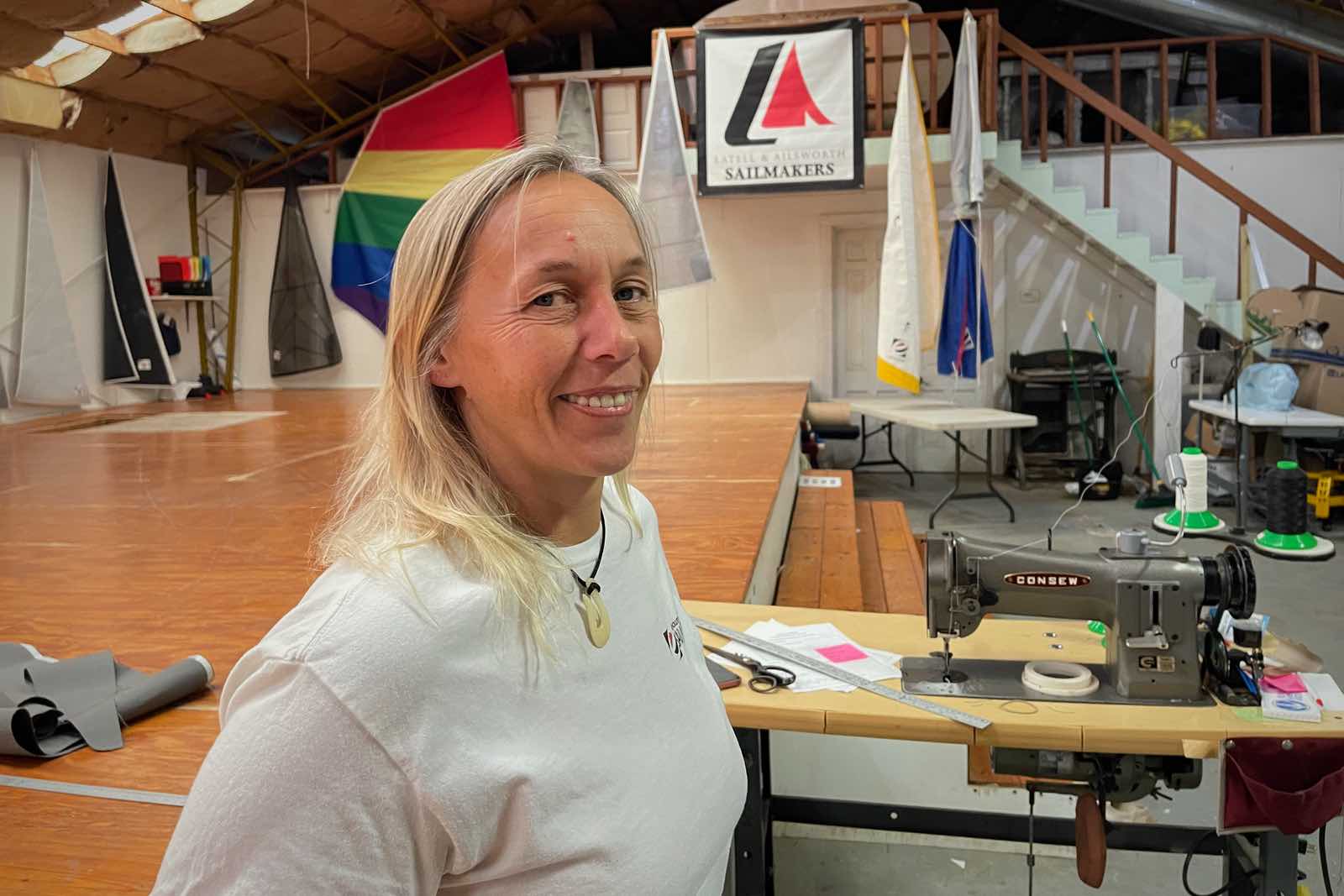It's Wednesday December 17, 2025
October 17, 2025
Awooden mallet pounding, smoothing out seams and stitches. The pulse of industrial sewing machines.Sections of fabric, or full sails, stretched out across the floor.
A barefoot sailmaker, pencil tucked behind their ear and measuring tape dangling from their shoulders. The sights and sounds of a sailmaking loft are part of Oriental.
Kristina Harborne of Evolution Sailmakers rips a seam on a sail.Kristina Harborne and Evolution Sailmakers is the newest entry in the Oriental sailmaking business.
For over 30 years, at least one, and often times multiple sailmaker businesses operated in town. Each “loft,” named for the raised work floor, has had its own unique niche. Serving the immediate Oriental boating community and regional markets, specifically sailboats and sailors. From repairs and maintenance to selling and building brand new sails.
All with a little friendly competition, and lots of connections across lofts along the way.
Oriental Sailmakers, 1987Wally Chapin founded Oriental Sailmakers in 1987. He brought his lifelong sailmaking experience, and young family, to Oriental by way of New England, having learned the trade from his father who was a WWII canvas man (his job was to inspect and repair parachute rigging).Wally’s father was also a sailmaker, and built cotton sails for the United States Coast Guard Eagle. The Eagle is a three-masted barque, actually awarded to the United States as reparations from Germany after WWII.
Wally Chapin, with daughter Carey Chapin and Laura Turgeon, who would go on to open Hodges Street Sails.Wally was also a canvas man in the Army, a job he got thanks to his father. Wally was drafted during the Vietnam war, but did not go to war. When he got out of the Army, Wally was manager for a sailmaking loft called McDougal’s, in New England.
Wally originally worked out of his family home on Hodges Street, with two young children in the house. Despite a small loft, Wally maintained relationships with larger sailmaking outfits, such as Hood Sails and Quantum Sails, to service larger boats.
Wally and son Ben at the original sail loft on Hodges Street.After years on Hodges Street, Wally moved the loft to a location on Broad Street next to Triton Yachts. It could accommodate up to a 70-foot luff (the front, forward edge of the sail). He cut sails by hand, and was well versed in drafting new sails by pencil and paper.
“Sometimes Ullman [the affiliate loft at the time] would cut the panels on bigger sails,” says Ben Chapin, Wally’s son. He worked for his dad at Oriental Sailmakers for years.
“We were working for the summer camps, building sails for Flying Scotts, Lightenings, Sunfish,” Ben says.
“He only ever did sails and canvas,” Ben says. “His entire life.” Wally passed away in 2017.
Wally shows off his sail at Oriental Sailmakers.Ben worked for Wally for several years, before branching out as a sales rep for Ullman Sales, and eventually going into retail at West Marine.
Inner Banks Sails and Canvas, 1991A few years after Wally Chapin got started, Mark Weinheimer and Luann Parins showed up. Also with ties to New England lofts, and worldwide America’s Cup sailmaking prestige.Hailing from the Great Lakes midwest, Luann started out as a waitress and Mark as a simple leather worker. He crafted gloves, belts, bags, and hitchhiked to sell them, while Luann waited tables. They loaded up a 1953 Chevy pickup truck with a camper they built in the back, and headed south for the sailing scene.
Mark, and Luann shortly after, were both hired as sailmakers for the first time in Florida in 1974. In a world of no double sided tape, let alone computer programs to design sails. In between they went sailing to the Bahamas on a 1937, 29-ft wooden boat. Starting to develop connections in the biz, and reputations, Mark and Luann were poached by America’s Cup contenders, San Diego Yacht Club. They worked in Hawaii while the boats practiced, and then in Australia for the actual race. One of their boat’s won. They also worked as contractors during the 1988 Americas Cup in California, when Cup holders San Diego Yacht Club hosted the event.
From there Mark and Luann managed a loft in California, and then worked for lofts in Annapolis before moving to Oriental and going out on their own. They purchased property off Button Gut as an empty lot. Then lived on their boat anchored off Broad Creek which the property juts up against. The boat had been an empty hull when they got it, but they had built the interior over time. Eventually they moved into a trailer on the property, and finished building their home in 1996.
Mark and Luann with a plaque commemorating the 1987 win of SV Stars & Stripes – with their sails aboard.While Mark started the business in sailmaking, Luann perfected her marine canvas sewing skills (upholstery, sun awnings and covers), working for Kathy Bruce at Down East Canvas, Luann says, located just outside of the village. She worked there for eight years before transitioning to working side by side with Mark.
Mark continued to churn out sails, while Luann sold and built canvas. From the original second story loft on Broad Street until 2002, the building originally built in the 1920s and now home to a yoga studio. “It was terrifyingly cramped,” Luann recalls of the second story loft they occupied at first. “It was one project at a time.”
Luann and Mark had more control over their next location. They entered into a commercial condominium agreement with the landowner, who was hoping to develop the land into a marine center. Complete with a rigger, yacht broker, and of course sailmaker. Inner Banks was the first business to buy in, owning their building but not the ground beneath it. By 2006, however, the marine industrial park never panned out and they were offered to buy their lot out right.
The crew was just fine on their own out there near the town water tower, visible from the shop window. Mark and Luann always had one full-time employee for 17 years. Some years they had as many as three.
“We hit the high spot in the economy,” Mark says, the business peaking around 2015.
“The business is such that its almost recession proof,” he says. “When its bad they fix things, when its good they buy things new.”
Mark and Luann always kept repair services, and small, less-profitable jobs on the menu in addition to building new. Whether it be repairing a zipper, a shoe, or even a French horn bag for a walk-in. Free work for the fire department, and sponsoring live music. It fostered a sense of community, which was ultimately good for business.
“There is potential for high value,” Luann says. “You have to spend some time tilling the dirt.That means a lot in a small community.”
LuAnn Parins at the sail loft in 2017, haivng put everything on top of the tables in anticipation of Hurricane Irene.After 47 years in the sailmaking biz, Mark Weinheimer and Luann Parins were ready to retire.
By 2020 Inner Banks Canvas and Sail had been for sale for six years. Having paid thousands to advertise in trade magazines, the couple had built a business over nearly thirty years, and wanted to pass it on: the skill and the brand, by training their successors on site. Potentials expressed interest, but never followed through. “Turns out sailmaking isn’t so romantic,” Mark says. “Being a sailmaker sounds romantic. After 47 years of doing it a lot of it is great hard work for not great pay.”
With no luck, the paper work had been filled out to dissolve the entity completely, when Breena and Spencer Litzenberger made an offer to buy Inner Banks Canvas and Sail, and all its remaining inventory. The Litzenbergers sailed into town after a decade as cruisers, and chose to settle down in Oriental and buy the business after seeing it advertised for sale on TownDock.net.
After initially operating as a sail and canvas business, the couple narrowed the business’ focus. They gave up sailmaking and the shop on Straight Road, and went mobile with canvas.
Hodges Street Sails, 2006Laura Turgeon and Gil Fontes like to stay somewhat under the radar. Their loft, Hodges Street Sails, is only a two minute walk from the free boat tie up at the town dock. For nearly twenty years, the loft has been a convenient place for cruisers and wayward sailors to stumble upon. Exclusively focused on repairs, modifications or upgrades to get the sailor back out to sea, or back out day sailing.“I pretty much did all the stitching, while Wally would take care of the office,” she recalls, “and guiding me in what I maybe didn’t know.”
Gil and Laura in 2008, when the loft was briefly a gallery space.Laura came with sailmaking experience from New England, having worked a Banks brand sail loft, a Doyle sail loft, and for Ullman Sails. Which is how Laura and Gil already knew Mark Weinheimer and Luann Parins.
“For that loft in New England [Banks] we would cut sails, and Mark and Luann would stitch them together,” Laura says.
Laura worked with Wally at Oriental Salimakers for three years, and would have continued on, she says, but he was downsizing.
“Wally was great to work with and for,” she says. “But we were forced to look at other options.”
Those other options, initially, included working at the then new restaurant in town, which was the Village Food Emporium, but people kept coming to Laura and Gil asking them to do sail repair. They eventually were so busy they were forced to go pro.
“The IRS was going to have something to say about it,” Gil chimes in with a chuckle, and still very much New England accent. “A couple jobs was okay but it was starting to get busier and busier. People already knew our work.”
Their home/business workspace originally functioned as an art gallery.
Laura repairing a sail at the inception of Hodges Street Sails.“Some of the photos we have between us show us as an art loft first,” Laura says. “Because that’s what we thought we would be, an art gallery. So all the painting come off the walls, the sculptures and rug came up off the floor. And we went to work as a sail shop legitimately.”
Repairing and maintaining sails . Including washing, restitching, replacing UV covers, upgrading from wire to rope luffs, installing reef points and more. Functioning mostly on repair, clientele range from day sailors to offshore, Gil and Laura do all their work from their home.
Although they don’t advertise for this service, customers do sometimes come to them asking for new sails, Gil and Laura said. They have a relationship with British Columbia sail design and Precision Sail Loft, which has its sailmaking loft overseas.
New sails are delivered to the Hodges Street location where they do a final inspection and install any battens for the customer. Gil says he sells about 10 news sails per year repping Precision.
From the early days of Hodges Street Sails: Gil takes a call.“We find we are busy enough that we don’t need to go to boats,” Laura says.
As a small, two person loft, Laura and Gil like to be in the shop to receive calls, sails, or inquiries rather than out measuring and installing sails. They will however, pick up and drop off sails from just about anywhere in town or on the water, then take them back to the shop for work.
“We will also recommend someone local for going to boats and helping people,” if needed, Gil says. But they find most customers come to them.
“It’s nice to make a living doing this,” Gil says. “But the people we meet, is really the biggest reward.”
With no plan to retire, no one is complaining. Working for themselves, and from home, affords a certain level of freedom.
“I get time to go in the studio,” Gil says. “Controlling your own time is a good thing, because we are both artists.”
Evolution Sailmakers, 2025The latest in what is now practically a tradition of sailmaking and canvas in the village is Evolution Sailmakers, formally known as Evolution Sailmakers by Latell and Ailsworth. The new sign at the intersection of Midyette and Broad Street displays the shortened name. Next door to Triton Yachts, it is the second building along the short gravel driveway. Red and black signage hangs from the overhead door, with a logo adorned company car parked outside.The building, already set up to be a sail loft from when Wally Chapin expanded Oriental Sailmakers, has functioned as a storage facility for years.
Inside is Kristina Harborne. A world traveler and yacht captain, Kristina is also a sailing instructor, word-class champion dinghy sailor, and former teacher. Originally from Cowes, England, she is still somewhat of a rookie sailmaker, having joined Evolution as a sales rep and sailmaking apprentice in 2024.
Kristina smoothes out a sail.“This was the next logical step for me,” Kristina says of becoming a sailmaker. “It was something I was always interested in doing, and what I wanted to do next. So this was an opportunity I couldn’t pass.”
Her collaboration with Evolution was by chance, after a series of events landed her in Oriental. Fresh off a job in Bermuda running a sailing school, Kristina flew to North Carolina to deliver a boat from Oriental back to Bermuda. While in town, she met someone and fell in love.
“He was like, you’re going to come back, right?” Kristina says. Referring to a local sailboat rigger she met while getting her client’s boat ready for the trip.
She came back on a tourist visa and was planning to head back to Bermuda to pursue sailmaking, when her now boyfriend, Ray Hocking, ran into Jerry Latell, the owner of a sailmaking loft in Virginia, at Ray’s place of employment: the boatyard at SailCraft Services.
Evolution Sailmakers had begun serving clients in Oriental via a mobile unit twice per month when Jerry and Ray met.
Top down view of Kristina at work.Before she was a sailor, Kristina (like her mother and grandmother) was a seamstress. She used those skills to make small repairs to dinghy sails during her sailing school years. Her intent was to get in to the sailmaking business in Bermuda. But after Ray introduced Jerry to Kristina, she headed to Virginia to interview with Evolution Sailmaking.
Jerry and Kristina struck a deal. She was granted a year long work training visa and returned to establish an Evolution Sailmaking branch in Oriental.
Kristina was living in the village but spending half the week at the loft in Virginia, training on making new sails, repairing sails, measuring and design, she says. She honed her skills in the Virginia loft, while scoping out a locations for a loft in Oriental.
“As this was an old sail loft it was perfect for us to just come put our machines in,” Kristina says.
The loft also handles smaller repairs, like this torn golf cart cover.Evolution Sailmakers kicked off the grand opening of the Oriental loft by hosting their first “Sock Burning Party,” at Triton Yachts in May, 2025. They welcomed the community with kegs of beer, a live local band, and oysters from Lighthouse Shoal Oysters in Merritt.
Kristina keeps busy measuring, designing, finishing and installing sails. While her workspace is large enough to build any sail on boats up to 50-feet, sails are fabricated at the Virginia headquarters utilizing the sailcloth and laser cutting table for all of her new builds. Kristina also does odd jobs, from occasional sail repair to canvas sail packs and covers, to selling second-hand and new but unused sails at the loft in Oriental.
“We want to function as an overflow loft,” she says. “The hope is that it gets busy enough to build sails here.”
Kristina’s boss Jerry says she’s right on time with 12 new sails delivered so far, and six currently in process.
Kristine Harborne at Evolution Sailmakers.“Kristina is a national champion dinghy sailor; the Laser 2000 two-person dinghy with a spinnaker,” Jerry brags about his latest employee and soon-to-be business partner.
Kristina is pursuing an investor visa in partnership with Evolution Sailmakers, creating a permanent home in Oriental.
Meanwhile, Kristina has become Oriental’s key sailmaker, with a loft off Broad Street.
Related Links• Evolution Sailmakers
• Hodges Street Sails
• Inner Banks Canvas
• Wally Chapin, 1949-2017
